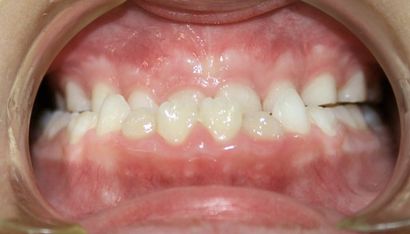Anterior Cross-Bite
Anterior Cross Bite
Call Today
Is the cross-bite minor or severe ?
This is often referred to as an “under-bite”. An anterior cross-bite is when the upper front teeth sit behind the lower front teeth (which is the reverse of a normal bite). This can involve single or multiple front teeth.

Possible Problems
An anterior cross-bite can result in poor facial aesthetics, chewing and speech difficulties. It can be difficult to clean or can lead to trauma to teeth and gum tissues.
Causes and Treatment Options
It is important to identify the cause of the cross-bite as the management can be very different.
The causes of anterior cross bite are:
Dental
These are a result of teeth tipping — upper incisors tipping back and /or lower incisor tipping forwards. The upper front teeth may have been knocked or the teeth could have developed ectopically. Treatment can be quite simple — tipping the teeth back into their favourable positions with simple appliances.
Skeletal
These involve a mismatch in the position of the upper and lower jaws. For example, the upper jaw is relatively far back compared to the forwardly placed lower jaw. This is referred to as Class III jaw pattern. Within this group, there is large variation in severity and jaw patterns which influences the type of treatment required. Some mild Class III with favourable facial pattern and sufficient overbite will benefit from early treatment with reverse pull head gear/face mask from 7 – 9 years of age. Hence, it is important that these cross-bite cases are seen by an orthodontist for an early assessment. In contrast, an adult who presents with a severe Class III would be offered a combination of orthodontics and jaw surgery to create the ideal bite with harmonious facial features.
Jaw Posture
Frequently, when an upper incisor tooth is positioned back, it interferes with a lower tooth during jaw closing. The lower jaw is then postured forwards to enable the back teeth to meet and chew. This initial contact and posture can be harmful to the teeth involved. Teeth can loosen, be worn down or become displaced from the arch, resulting in gum recession i.e. traumatic bite. The forward posture can also exacerbate the forward growth of the lower jaw which is undesirable in a Class III pattern. When there are signs of traumatic occlusion and posture, it is beneficial that the child be assessed early (7 – 8 years) and have the cross-bite corrected
Talk About Your Options
Call Now
Hours
Monday 8:00 am - 6:00 pm
Tuesday 8:00 am - 6:00 pm
Wednesday CLOSED
(open for administration)
Thursday 8:00 am - 6:00 pm
Friday CLOSED
(open for administration)
Saturday 8:00 am - 1:00 pm
(open 1 in every 6 weeks)
Contact
Address
940 Doncaster Rd,
Doncaster East VIC 3109
Get In Touch
Contact Us
Thank you for contacting us.
We will get back to you as soon as possible
We will get back to you as soon as possible
Oops, there was an error sending your message.
Please try again later
Please try again later
